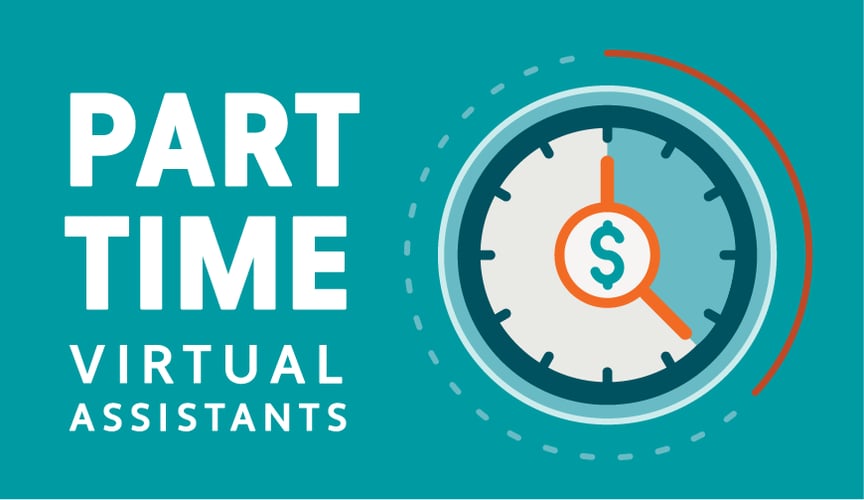One of the questions executives ask when considering hiring a virtual assistant is whether it should be a full-time or part-time role. The question comes up in a couple of different ways:
- Do I have enough work to offload to warrant a virtual assistant?
- I had a full-time assistant when office-based, but now that I'm working from home, do I need the same amount of support?
The short answer is that very few executives need a full-time assistant. We've learned that through providing more than 1,000,000 hours of service to thousands of executives for more than a decade. There are several reasons for this, and we will explain.
Changing Role of the Administrative Assistant
The shift to all or primarily remote work has forced an abrupt change to millions of jobs, and the executive assistant is one of them. For many businesses, the administrative assistant was a fixture in the office in the reception area or near the executive's office. In most cases, the admin had to be a full-time job because someone had to be there during office hours. Typical responsibilities included:
- Greeting visitors
- Answer phone calls
- Opening the mail and responding to emails
- Office events
- Scheduling appointments for executives
- Submitting expense reports
- Planning travel
Recommended Reading: 5 Myths About Virtual Executive Assistants Busted
Remote Work Changed Everything
The remote work revolution started before the 2020 pandemic but was accelerated as offices closed their physical doors. That meant:
- No in-person visitors or meetings
- Reduced travel
- Reduced expenses to report
- No office phone to answer
Suddenly, every administrative assistant was a virtual assistant. This shift has created opportunities for new roles and responsibilities. An admin's need to be in the office all day went away, and many executives found that assistants got more done in less time.
Digital First Business World
Remote work has been enabled and accelerated by the pandemic. As of 2019, some 89 percent of businesses adopted a "digital-first" strategy, creating online versions of themselves, enabling their products and services to be accessed anywhere. This strategy's byproduct has unleashed apps and tools designed to make people, including executives, self-sufficient.
As a result, the administrative assistant's role has changed from a personal assistant to a digital assistant. The proliferation of productivity tech has not eliminated admin work but has shifted its functions to the cloud. Cloud-based administrative functions include:
- Communication—Zoom, Slack, Gmail
- Contact management—Salesforce, Sugar CRM, Pipedrive
- Marketing—HubSpot, Adobe, SalesLoft
- Project Management—Trello, Asana, Monday
- Travel—Tripit, Google Flights, TripActions
- Prospecting—ZoomInfo, LinkedIn, Yesware
- Finances—Expensify, QuickBooks, Concur
These are just a few of the most commonly used tools and technologies most businesses use.
More Work Gets Done Faster
The list goes on. These tools and more like them are digital from the ground up, designed to speed up admin work. And they do, from anywhere. But they still take time to use, and that's why DIY executives spend 16 hours a week on admin work. But 16 hours per week is nowhere close to a full-time job, hence the rising demand for virtual assistants.
Higher Level Tasks
The arrival of so many digital tools has also enabled admins to contribute to businesses at a higher level. The tools are easy to learn and use—few require specialized training or certification. Tech-savvy virtual assistants can perform tasks previously made difficult by disconnected roles and locations. Virtual assistants can provide services like:
- Email communications
- Sales prospecting
- CRM management
- Email campaigns
- Sales follow up
- Event planning
- Invoicing and payment processing
- Pulling BPM and CRM reports
- Document prep (sales sheets, job descriptions)
Providing high-value services like CRM data entry and maintenance can save entrepreneurs hours, and the ripple effect of a clean CRM multiplies the benefits. Timely invoicing with reminders and follow-ups on past-due payments can dramatically improve cash flow.
Having someone manage your inbox and forward you only the messages that need immediate attention is another great time-saver.
The Sweet Spot: 55 Hours Per Month
After years of tweaking our model, we've found that 55 hours per month is the ideal time needed for virtual admins to support a single executive fully. That's about one-third of a full-time employee.
Most of our assistants help three executives and work together to provide backup coverage when one is sick or on vacation. All assistants are trained and fluent in the digital technologies businesses use and excel at turning tasks into repeated processes that accelerate over time.
There are many models of virtual assistant service delivery:
- Individual freelancers you find by word of mouth
- Contractor agencies provide you with a list of applicants to choose from
- Fully managed service (our model) that hires assistants as W-2 employees, trains them, and manages their performance and professional development behind the scenes
If you're looking for information about what it's like to work with a Prialto virtual assistant, check out this guide.
About the Author: Bill is Prialto's senior content marketing manager and writes about the future of work and how businesses can be more productive and successful. His work has appeared in the World Economic Forum Agenda blog and CIO magazine.

